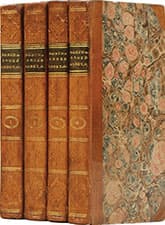Northanger Abbey
Critique • Quotes • At the movies
 First edition of Northanger Abbey and Persuasion, 1818
First edition of Northanger Abbey and Persuasion, 1818First publication
1817
Written
1794–1799, revised 1803
Literature form
Novel
Genres
Literary, satire
Writing language
English
Author's country
England
Length
Approx. 78,000 words
Love story emerges from satire
Northanger Abbey is the satire on popular literature Jane Austen had to write before she could get down to creating her own classics. It often happens in a first novel an author is driven to imitate and have fun with the work of one or more predecessors who have been influences during the formative years. A sort of ritual clearing out of the cobwebs before one's own sensibility can flourish into the natural light.
As every Austen fan knows, Northanger Abbey was written more than a decade before any of her books reached the public. It finally received publication after her death, making it both her first completed novel and her second-last published.
If you read it last among Austen's works, you may at first be disappointed to find the plot somewhat hackneyed and characters thinner than you may be used to from her "earlier" works. As if her skill and creativity have declined.
And all those references to ridiculous-sounding novels and literary figures of the long past!
This is the satirical side of Northanger Abbey. Austen presents her main character as a young woman (seventeen actually) besotted with the Gothic romances she had herself devoured in her teens. Country clergyman's daughter Catherine Morland projects their plots and characters onto her own experiences.
At least in part. You may notice these obsessions come and go. They recede when Catherine is introduced to the winter ball season at the resort city of Bath, which seems to exist as a setting for eligible young women to seek wealthy young men, the perfect launching for a familiar Austen plot. They reach their peak at about mid-novel when Catherine visits and fixes her dark imagination on the not-so-dark nor mysterious mansion of Northanger Abbey. And then they're blown away completely as her love interest, Henry Tilney, brings her to her senses.
Outline for an Austen novel
This waxing and waning of the Gothic theme is sometimes attributed to Austen repeatedly changing her focus as she wrote the book over several years, and perhaps not handling a lead character's transitions as adeptly as she later would.
Be this as it may, it also illustrates the first blossoming of Austen's own novelistic sensibility. We have here the birth of many, if not all, of the elements of a Jane Austen novel, at least in outline form:
• The country gentry setting for a large family with daughters to be married off.
• The plucky, well-intentioned and, in one respect, misguided heroine.
• The sensible, sincere—and well-to-do—young man she is drawn to.
• His opposite, a dashing young man who takes and breaks women's hearts (in this case, Henry's brother "Captain" Frederick).
• The comeuppance when the heroine has her eyes finally opened to some truth she has misapprehended all along.
• The showdown between marriage based on social advantage and marriage based on affection.
• The penultimate plot twists by which the heroine's hopes are dashed—and then resuscitated when her beloved comes riding to the rescue.
• A happy marriage. Or two.
Most of these elements are not explored as deeply or displayed as prominently as in Austen's later fictions, but they are here in embryo at least. And frankly, they form the part of the narrative that is most engaging now to readers who care little for the passages of literary parody.
Those satiric passages are entertaining though. And even in its truncated form the blossoming Austen narrative is deftly written, offering the wit, incisive observations and clever plotting that distinguishes all her work, making each novel a different experience.
Winking to the readers
An added charm in Northanger Abbey is Austen's own comments, addressed to readers concerning some of the potential weaknesses of the novel they might discern. For examples:
...it may be stated, for the reader's more certain information, lest the following pages should otherwise fail of giving any idea of what her character is meant to be, that her heart was affectionate; her disposition cheerful and open, without conceit or affectation of any kind....
I leave it to my reader's sagacity to determine how much of all this it was possible for Henry to communicate at this time to Catherine, how much of it he could have learnt from his father, in what points his own conjectures might assist him, and what portion must yet remain to be told in a letter from James.
...my readers, who will see in the tell-tale compression of the pages before them, that we are all hastening together to perfect felicity.
The last example comes just a couple of pages before the end, as Austen is obviously rushing toward the requisite happy wedding without taking the time to lay the entire groundwork. In future she wouldn't need such winks to the audience.
In her next completed novel and first published work, Sense and Sensibility, the author would again cast a satiric eye at a literary tradition of her time. But that theme is worked more integrally into the more thoroughly developed story, such that an innocent reader might never notice.
Still it's worth reading Northanger Abbey, this earlier attempt, as perhaps not in the class of Jane Austen's greatest works, but as a look into what they sprang from. And, in its own right, as one of the more fun novels of its time.
— Eric
Critique • Quotes • At the movies

